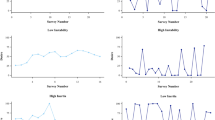Abstract
Plethysmographic testing was completed on 100 research participants from the same medium-security prison population, 50 of whom were incarcerated for nonsexual offenses. In order to strengthen the validity of the research, only participants who achieved full arousal were included in the sample, and the percentage of full erection scores, as well as the Rape Index, were examined. The resulting sexual arousal profiles revealed striking similarities between rapists and control participants, indicating that deviant arousal alone did not distinguish these sexual offenders from nonsexual offenders. The only marked difference between the two groups was in the almost-perfect ability of control participants to inhibit deviant arousal and the weak ability of sexual offenders to accomplish this. The suggestion was advanced that a determination of an offender's ability to inhibit deviant arousal may be the only aspect of plethysmographic testing which has practical application in the assessment of rapists.
Similar content being viewed by others
REFERENCES
Abel, G. G. (1990). Self-reported sex crimes of nonincarcerated paraphiliacs. Presentation in panel discussion at the annual meeting of the Association for the Treatment of Sexual Abusers in Toronto, Ontario, Canada.
Abel, G. G., Barlow, D. H., Blanchard, E. B., & Guild, D. (1977). The components of rapists' sexual arousal. Archives of General Psychiatry, 34, 895-903.
American Psychiatric Association (1994). Diagnostic and statistical manual of mental health disorders, 4th ed. Washington, DC: American Psychiatric Association Press.
Barbaree, H. E., & Marshall, W. L. (1989). Erectile responses amongst heterosexual child molesters, father-daughter incest offenders, and matched non-offenders: Five distinct age preference profiles. Canadian Journal of Behavioral Science, 21, 70-82.
Barbaree, H. E., Baxter, D. J., & Marshall, W. L. (1989). The reliability of the Rape Index in a sample of rapists and nonrapists. Violence and Victims, 4, 299-307.
Barker, J. G., & Howell, R. J. (1992). The plethysmograph: A review of recent literature. Bulletin of the American Academy of Psychiatry and the Law, 20, 13-27.
Baxter, D. J., Barbaree, H. E., & Marshall, W. L. (1986). Sexual responses to consenting and forced sex in a large sample of rapists and nonrapists. Behaviour Research and Therapy, 24, 513-520.
Blader, J. C., & Marshall, W. L. (1989). Is assessment of sexual arousal in rapists worthwhile? A critique of current methods and the development of a response compatibility approach. Clinical Psychology Review, 9, 569-587.
Campbell, J. C. (Ed.) (1995). Assessing dangerousness: Violence by sexual offenders, batterers, and child abusers. Thousand Oaks, CA: Sage.
Earls, C. M. (1992). Clinical issues in the psychological assessment of child molesters. In W. O'Donahue & J. Geer (Eds.), The sexual abuse of children: clinical issues. Hillsdale, NJ: Lawrence Erlbaum.
Earls, C. M., & Proulx, J. (1986). The differentiation of Francophone rapists and nonrapists using penile circumferential measures. Criminal Justice and Behavior, 13, 419-429.
Fedora, O., Reddon, J. R., & Yeudall, L. T. (1986). Stimuli eliciting sexual arousal in genital exhibitionists: A possible clinical application. Archives of Sexual Behavior, 15, 417-427.
Fedora, O., Reddon, J. R., Morrison, J. W., Fedora, S. K., Pascoe, H., & Yeudall, L. T. (1992). Sadism and other paraphilias in normal controls and aggressive and nonaggressive sex offenders. Archives of Sexual Behavior, 21, 1-15.
Freund, K. (1972). A note on the use of the phallometric method of measuring mild sexual arousal in the male. Behavior Therapy, 2, 226-228.
Freund, K., & Blanchard, R. (1981). Assessment of sexual dysfunction and deviance. In M. Hersen & A. Bellack (Eds.), Behavioral assessment: A practical handbook, 2nd ed. New York: Pergamon.
Hall, G. C., Schondrick, D. D., & Hirschman, R. (1993). The role of sexual arousal in sexually aggressive behavior: A meta-analysis. Journal of Consulting and Clinical Psychology, 61, 1091-1095.
Howes, R. J. (1998). A comparison of plethysmographic profiles of stranger and spousal rapists. Research in progress. Stony Mountain Institution, Winnipeg, Manitoba, Canada.
Howes, R. J. (1995). A survey of plethysmographic assessment in North America Sexual Abuse: A Journal of Research and Treatment, 7, 9-24.
Lalumiere, M. L., & Quinsey, V. L. (1993). The sensitivity of phallometric measures with rapists. Annals of Sex Research, 6, 123-128.
Lalumiere, M. L., & Quinsey, V. L. (1994). The discriminability of rapists from non-sex offenders using phallometric measures: A meta-analysis. Criminal Justice and Behavior, 21, 150-175.
Langevin, R. (1989). Sexual preference testing. Toronto: Juniper Press.
Langevin, R., Hucker, S., Ben-Aron, M., Purins, J. E., & Hook, H. H. (1985). Why are pedophiles attracted to children? In R. Langevin (Ed.), Erotic preference, gender identity, and aggression in men: New research studies. Hillsdale, NJ: Lawrence Erlbaum Associates.
Maletzky, B. M. (1991). Treating the sexual offender. Newbury Park, CA: Sage.
Murphy, W. D., Krisak, J., Stalgaitis, S., & Anderson, K. (1984). The use of penile tumescence measures with incarcerated rapists: Further validity issues. Archives of Sexual Behavior, 13, 545-554.
Murphy, W. D., Haynes, M. R., Coleman, E. M., & Flanagan, B. (1986). Sexual responding of “nonrapists” to aggressive sexual themes: Normative data. Journal of Psychopathology and Behavioral Assessment, 8, 37-47.
Quinsey, V. L., Chaplin, T. C., & Varney, G. (1981). A comparison of rapists' and non-sex offenders' sexual preferences for mutually consenting sex, rape, and abuse of women. Behavioral Assessment, 3, 127-135.
Quinsey, V. L., Chaplin, T. C., & Upfold, D. (1984). Sexual arousal to nonsexual violence and sadomasochistic themes among rapists and non-sex offenders. Journal of Consulting and Clinical Psychology, 52, 651-657.
Wormith, J. S. (1986). Assessing deviant sexual arousal: Physiological and cognitive aspects. Advances in Behavioral Research and Therapy, 8, 101-137.
Wydra, A., Marshall, W. L., Earls, C. M., & Barbaree, H. E. (1983). Identification of cues and control of sexual arousal by rapists. Behaviour Research and Therapy, 21, 469-476.
Author information
Authors and Affiliations
Rights and permissions
About this article
Cite this article
Howes, R.J. Plethysmographic Assessment of Incarcerated Nonsexual Offenders: A Comparison with Rapists. Sex Abuse 10, 183–194 (1998). https://doi.org/10.1023/A:1021313820005
Issue Date:
DOI: https://doi.org/10.1023/A:1021313820005




